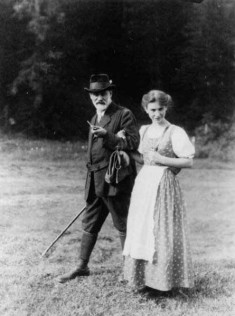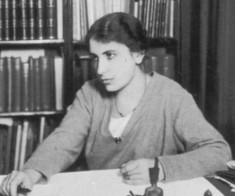| Anna Freud | |
|---|---|
 |
|
| Psychologist | |
| Born | Dec. 3, 1895 Vienna |
| Died | Oct. 9, 1982 (at age 86) London |
| Nationality | Austrian |
Anna Freud was the sixth and youngest child of her famous father, Sigmund Freud. She followed her father into the field of psychology where she made highly influential contributions both to the theory of mind and to therapeutic psychology. Like her father, Anna Freud’s theories brought both praise and considerable controversy.
Anna’s Childhood Years
Anna Freud’s childhood is described as unhappy and troubled, largely due to intense rivalries with her siblings. Her mother, Martha Bernays, married Sigmund Freud in 1866. She bore all six of his children. Anna was born in 1895.
Anna’s rivalry with her sister Sophie was a classic battle between “beauty” and “brains.” Anna was extremely intelligent, but not considered attractive, while Sophie was widely regarded for her luxurious feminine looks and charm.
Anna was also disturbed in other ways. She complained to her father of being deeply troubled by her own thoughts, feelings, and fantasies. Extremely thin, she suffered from depression and may have struggled with an eating disorder.
Following Her Father’s Footsteps
Anna Freud was educated at the Cottage Lyceum in Vienna in 1912, but she said her real education came through the study of her father’s work. She had a natural facility with languages and could speak French, English, and Italian fluently in addition to her native German.
Her first job was that of teacher at her former school, the Cottage Lyceum. During these early years, she continued to suffer from depression, however, and struggled to maintain her overall health. She decided to leave teaching and to become seriously involved in learning the depths of her father’s conceptions of psychology and psychoanalysis.
Anna’s Work with Children
In an attempt to confront her own inner troubles, Anna underwent psychoanalysis by her father. Upon completing her treatment, she wrote her first academic paper – Beating Fantasies and Daydream, which she presented to the Vienna Psychoanalytical Society in 1922.
This work earned her membership in the Society and established her credentials in the field of psychology. She was able to set up her own therapeutic practice where her focus was on the treatment of children. She also began teaching child psychoanalysis techniques at the Vienna Psychoanalytical Society.
At the center of Anna Freud’s theories was the understanding and dealing with the ego. She specifically wanted to understand how the ego formulated defenses to protect itself from perceived threats from the outside — from other people, family members, from society and from one’s own unhealthy fantasies. To this end she published The Ego and the Mechanisms of Defense, which became an influential document that shaped the direction of therapeutic psychological treatment for children.
Fleeing the Nazi Threat
In 1938, Freud, who was Jewish, was forced to flee her native Vienna for England as the Nazis of Germany began their widespread persecution of Jews across Europe. A year later, her father, Sigmund Freud, died in London. He had been ill with cancer for some time, and so it was Anna who organized the escape of her entire family to England. Anna was also her father’s primary caregiver through his years of battling jaw and throat cancer.
Continuing Work in Psychology
The war provided much opportunity for Anna Freud to continue her work with both the psychological treatment and study of children. The war produced large numbers of orphans and/or displaced children. She established The Hampstead War Nursery, which was a refuge and orphanage.
She was able to study the effects of the loss of father and mother figures on child personality, and formulate methods that children could use to forge new psychological bonds with other father and mother figures.
Rivalry with Melanie Klein
 Anna Freud was often a figure of controversy and frequently in conflict with others. She seems to have carried over the intense sibling rivalries of her childhood into her adult years. She squared off in an intense competition with another prominent female child psychologist, Melanie Reizes Klein.
Anna Freud was often a figure of controversy and frequently in conflict with others. She seems to have carried over the intense sibling rivalries of her childhood into her adult years. She squared off in an intense competition with another prominent female child psychologist, Melanie Reizes Klein.
Freud and Klein held deep differences of theory, opinion, and approach for the proper psychological treatment of children. The impasse became so profound within the professional community that the British Psychoanalytical Society organized a series of meetings to resolve the issues. These meetings came to be known as “The Controversial Discussions.”
While no true resolution or compromise was formed between the theories of Freud and Klein, the results of the Controversial Discussions was a formulation of policies and standards within the profession of psychology. These events took place between 1942 and 1944.
Legacy and Death
Anna Freud went on to produce an enormous amount of work, publishing a number of influential books on child psychology which set forward her theories centered on ego development, the dysfunctions of the ego, and how to deal with them. Her work has always been controversial and clashed with other major schools of thought that developed concurrently with hers through the 20th Century.
Freud traveled frequently to the United States, teaching and lecturing. She died at the age of 86 in London in 1982. She never married.